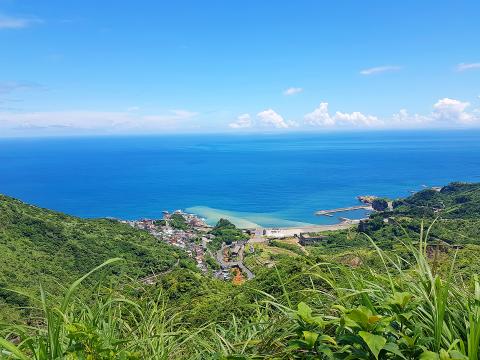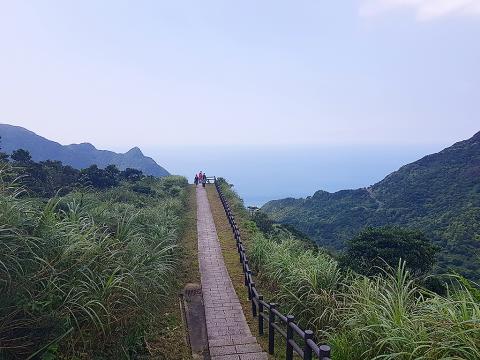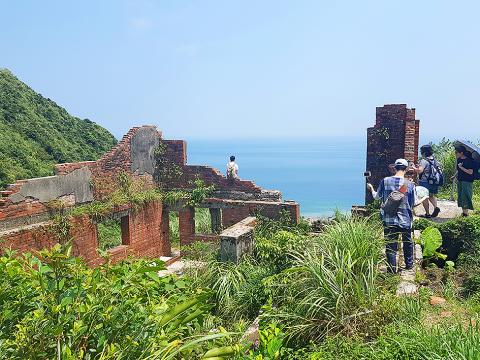Mention of group tours to the under-forties evokes jabbering, selfie-taking, middle-agers zig-zagging across Taipei streets or monopolizing space at Sun Moon Lake. From the inside, group tours seem even more bizarre to this demographic. One twenty-something acquaintance, who recently returned from Kyoto, Japan, puzzled over the fact that not a single word was exchanged among his party and the other five families on the trip. Group tours, in short, have a reputation for being insular for those on them, and a nuisance and the butt of jokes for everyone else.
But group tours are more common among young hipsters than most would like to admit, and they’ve become especially popular over the past few years — boosted in large part by social media. What makes one of them, Taipei Hikers, worthwhile is that they are well-organized, free and give the uninitiated and inexperienced a chance to trace Hualien’s crystalline streams or climb New Taipei City’s mountains, which offer stunning vistas of coastal villages and jungle rich in flora and fauna.
I went on such a tour with Taipei Hikers on Aug. 4 to Teapot Mountain (茶壺山, signs on the mountain Romanize it as Cha Hu Shan). The Facebook group, started by former Taipei Times contributor Richard Saunders and maintained by a close-knit group after he returned to the UK last year, led us on the relatively leisurely four-hour trek.

Photo: Noah Buchan, Taipei Times
TAIPEI HIKERS
While taking the 90-minute 1062 bus from the Zhongxiao-Fuxing MRT, Exit 2, to the trailhead earlier this month, Mars, our group leader, told me that the typical group tour differs from Taipei Hikers because the latter is free. This means that a lot of the problems associated with financial transactions — the certainty that you will be pressured to buy products or visit sites of no interest — are nonexistent.
For the most part, the only problems he has encountered since starting to do these tours in 2012 are people who don’t prepare properly.

Photo: Noah Buchan, Taipei Times
And this is the thing about Taipei Hikers: there are no mysteries as to what you are going to expect on the tour because they provide you with all the necessary details. From the Facebook post:
“Teapot Mountain, the well-named rocky peak looming above the old gold/copper mining town of Jinguashi (金瓜石) on the northeast coast. From there it’s on to the impressive ridge of Banping Mountain (半屏山) and then Canguangliao Mountain (燦光寮山), the highest peak in the area, before looping back down to Jinguashi.”
Other details include the skill set necessary for the ascent — “moderate walk, along mainly good trails, but expect lots of steep climbs, a couple of easy rocky climbs (with fixed ropes) and overgrown trails” — and what to bring: lunch, water, sun cream, a hat and a metro card that has at least NT$250 for the bus ride out and back. Simple, right?

Photo: Noah Buchan, Taipei Times
Wrong. Even with those detailed instructions, after we get off the bus at Cyuanji Temple (勸濟堂) and introduce ourselves, I notice Mars staring at a woman’s footwear, which would be more appropriate on a ballet stage than the side of a mountain. He questions, she deflects, saying she’ll be fine. He insists that the slippers are inappropriate. She says she’ll try and go as far as possible. He shrugs and proceeds to begin the climb — up cement stairs beside the temple’s public toilets.
The reality is that the first 20 minutes of the hike aren’t that difficult, so her footwear wouldn’t have made much of a difference. Reaching the top of the stairs we turn left and walk for 100m or so to the base of some wooden stairs on the left that lead up to the first observation platform with views of the surrounding valley and ocean. Skip this if you plan to do the entire hike because there is much more to see above. Rather, continue right along the road, past a redbrick ruin on the left (where influencers are plying their selfie trade) around a bend to the trailhead at the right (just beyond two port-a-potties). This is where the challenge — and the need for proper footwear — begins.
Whereas we first started as a group, now we can see who has experience climbing. The first pavilion is a 20-minute climb from where we stand and I notice that many keeners are falling behind as they make their way to the first pavilion.

Photo: Noah Buchan, Taipei Times
After a 15-minute rest, we continue on as a group up a winding paved road to a second trailhead that will bring us up to the second pavilion, which is just below Teapot Mountain. The short rest seems to have made everyone chatty. Everyone breaks off into groups of two or three, and I find myself talking to an Australian couple who plan to travel around Taiwan over the next few months.
EATING GRASS
While approaching an observatory platform between the first and second pavilions, the architect pair tell me that working remotely has enabled them to travel Asia — something they plan to do for the next few years. As we chat, an ex-paratrooper hooks up with us. Trained to survive in the mountains for weeks at a time, he whips out his knife and chooses some tall grass that grows along much of the mountain path, trims off the bits that aren’t edible and hands me the stalk. As I nibble on the nub, which has the texture of lemon grass but the flavor of unsalted potato chips, he proceeds to cut down a mini-forest to distribute among the others. It is like this, stalks hanging out of our mouths, that we continue up to the second pavilion for a brief rest before ascending the teapot.

Photo: Noah Buchan, Taipei Times
The views become ever more spectacular as you ascend — and our group becomes ever more chatty as we all loosen up. Mars tells us that summiting the teapot isn’t so difficult for the initiated, but might be intimidating for those who are not. Also, and we can see this a few hundred meters from the pavilion, there will be a lineup, which can create a bottleneck.
Two choices here: summit through a narrow hole that brings you to a rope ladder that descends to a ledge overlooking the valley below, which takes about five minutes; or descend through a cave that brings you up on the other side of the ledge and avoids the inevitable bottleneck on the summit. As it was my first time and it was the group thing to do, I summited, an easy enough feat and worthwhile for the views (in a subsequent climb, I skipped it because the lineup was too long).
After 30 or so minutes, we climb down off the ledge and descend 45 minutes along a gravelly path to Banping Mountain.
This is the most difficult part of the climb we experience that day — and makes it clear who are the outdoor enthusiasts and who has difficulty getting off the couch. Between taking notes and photos, I’ve fallen behind, with only our group leader and a couple, one from Taiwan, the other Hong Kong (I didn’t have a chance to ask the guy from Hong Kong how he feels about the protests).
I’m alone by the time I reach the roughly 50-meter vertical rope ladder that will bring me to the summit of Banping Mountain. Mist is funneling down from the ridge above as I make my way up to the top, where I am met with slight drizzle. After a quick rest, I move right along the ridge, past a man serenely reading by himself amid the gloom and catch up to the Aussies, who proceed to tell me about a week-long hike they plan to do in Australia in the near future: one thing is for certain, most of the non-Taiwanese I met are a fountain of information on how to trek in other countries.
HERE COMES THE RAIN
Rain has given way to partly sunny skies, and though I cannot see much, I know from a subsequent trip that the gray clouds hide astounding 360 degree mountain and ocean views. As the three of us descend Banping Mountain, the rocky path meets up with a road, where most of the group has assembled. As we linger, we discuss whether or not to go left and ascend the planned Canguangliao Mountain, or skip it due to the ominous clouds that keep moving over us, and descend towards Jinguashi. We decide on the latter.
As we descend, I strike up a conversation with a South African restaurateur who has lived in Taiwan for over a decade and has a bewildering number of catering and restaurant ideas. If I’ve learned anything about this (and many previous) group treks, is that everyone eventually has a story to tell or an idea to mull with otheres — a vibe, I suspect, that group leaders like Mars help to cultivate. He’s an unobtrusive presence, emerging to offer a word of encouragement here or a direction change there.
The 30-minute jaunt along stone walkways and steps from the road to the trail terminus sees most of us walking alone, lost in our own thoughts, though we all eventually meet at a shrine five minutes above Jinguashi. As we enter through the back part of the park, we scatter again — some to get ice cream, others to fill up their water bottles and some to use the bathroom.
It’s 3:30pm when a handful of us decide that we are going to take an early bus back — each of us sitting separately, but united in knowing that we got to share someone about each other, if only for a day under a teapot in northern Taiwan.
— Steven Crook’s Highways and Byways will return to this space next week.

Most heroes are remembered for the battles they fought. Taiwan’s Black Bat Squadron is remembered for flying into Chinese airspace 838 times between 1953 and 1967, and for the 148 men whose sacrifice bought the intelligence that kept Taiwan secure. Two-thirds of the squadron died carrying out missions most people wouldn’t learn about for another 40 years. The squadron lost 15 aircraft and 148 crew members over those 14 years, making it the deadliest unit in Taiwan’s military history by casualty rate. They flew at night, often at low altitudes, straight into some of the most heavily defended airspace in Asia.

Many people in Taiwan first learned about universal basic income (UBI) — the idea that the government should provide regular, no-strings-attached payments to each citizen — in 2019. While seeking the Democratic nomination for the 2020 US presidential election, Andrew Yang, a politician of Taiwanese descent, said that, if elected, he’d institute a UBI of US$1,000 per month to “get the economic boot off of people’s throats, allowing them to lift their heads up, breathe, and get excited for the future.” His campaign petered out, but the concept of UBI hasn’t gone away. Throughout the industrialized world, there are fears that

Like much in the world today, theater has experienced major disruptions over the six years since COVID-19. The pandemic, the war in Ukraine and social media have created a new normal of geopolitical and information uncertainty, and the performing arts are not immune to these effects. “Ten years ago people wanted to come to the theater to engage with important issues, but now the Internet allows them to engage with those issues powerfully and immediately,” said Faith Tan, programming director of the Esplanade in Singapore, speaking last week in Japan. “One reaction to unpredictability has been a renewed emphasis on

Taiwan’s democracy is at risk. Be very alarmed. This is not a drill. The current constitutional crisis progressed slowly, then suddenly. Political tensions, partisan hostility and emotions are all running high right when cool heads and calm negotiation are most needed. Oxford defines brinkmanship as: “The art or practice of pursuing a dangerous policy to the limits of safety before stopping, especially in politics.” It says the term comes from a quote from a 1956 Cold War interview with then-American Secretary of State John Foster Dulles, when he said: ‘The ability to get to the verge without getting into the war is